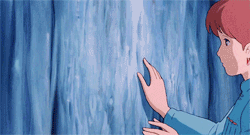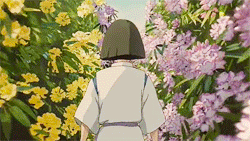Written by Myrna Waldron.
 |
| Nausicaa hears the bubbling healthy water inside a petrified tree |
- Unlike the previous three reviews for this “retrospective,” I was going into this review almost completely blind. I had not seen Nausicaä before today, and only knew that it was a film with a strong female protagonist and a lot of flying around on gliders. Thinking back on it now that I’ve seen the film, it is definitely very good, but I do not consider it on the same artistic level as Princess Mononoke or Spirited Away. The film is unmistakably Miyazaki, as it has his favourite themes of pacifism, environmentalism, feminism, and “Things that fly are really cool.” I think the pacifism and environmentalism themes were a lot more heavy-handed in Nausicaä than they were in Princess Mononoke. I also found the characterization kind of lacking — I can’t even remember the names of most of the male characters. The animation is incredible, of course. The music is a mixed bag. “Normal” scenes are scored simply, with the soundtrack only adding necessary emotional pull. Scenes where the insects rampage, however, are scored with a distinctly 80s-sounding electronic fast-paced musical style which, I feel, conflicts with the rest of the film. It reminded me a lot of boss battle music that you find in video games. Oh well!
- I decided to just watch the movie with the English dub on — as I was seeing the film for the first time, it would have been very hard for me to follow two scripts at once without already knowing what the characters are saying and what is going to happen. The English dub is…okay. I was practically gleeful to hear Patrick Stewart’s voice. He could narrate the recipes on the back of a soup can and I’d listen enraptured. I have to say that Alison Lohman was a lacking heroine. She said far too many of her lines in the exact same intonation. I have no idea why they cast Shia LeBoeuf in anything, because his voice isn’t particularly notable, and his delivery was average. Heh, remember when Hollywood tried so hard to make Shia LeBoeuf happen? Uma Thurman was decent as Princess Kushana — there was definitely a lot of coldness and bitterness in her delivery, which gave the character much needed development. And, because I did not check the Japanese script, I don’t know if this is a problem specific to the English script or what, but it drove me NUTS that the characters kept referring to Nausicaä as “The Princess” or “Princess” as if she didn’t have a name. Also, comparing my notes to the TV Tropes article, it seems that the English dub mispronounced/mistranslated a few terms — I heard Torumekian as “Tolmekian” and Ohmu as “Ohm.”
- Speaking of Princesses, Nausicaä and Kushana make a very interesting comparison to the traditional Disney-style fairy tale princesses we’ve come to grow up with. Most notably, both of them are tremendously proactive. They don’t wait for other people to do their tasks for them; they act immediately. Nausicaä is tomboyish rather than traditionally feminine. Kushana retains some femininity, but it heavily contrasts with her warlike ambitions and her armour-like prosthetics. There are no tiaras or poofy dresses here — neither woman has any time for that kind of crap. Neither one has any romantic ambitions or entanglements either, as both tremendously value their independence. I suspect that Kushana is meant to be a strong counterpoint to Nausicaä. Kushana is bitter where Nausicaä is optimistic, vengeful instead of peaceful, etc. There is one thing that bothers me though. Both of Nausicaä’s parents are dead, so shouldn’t she now be a Queen, not a Princess? I can understand the Valley of the Wind’s people being reluctant to acknowledge the murder of their sovereign and do not have time to hold a coronation, but to continue to call her Princess robs her of a chance to gain a significant leadership role. The Disney Princesses always remain Princesses. They can get married, have children, and the parents are nowhere to be found, but they must never become rulers. In Kushana’s case, I discovered via TV Tropes that in the extended Nausicaä manga, she has a living father and brothers, so it is understandable that she is still “Princess” despite her obvious leadership role.
 |
| Nausicaa flies into a rage after her father is murdered |
- Nausicaä is a well-developed female protagonist, and Kushana is also a decently developed female antagonist, but I found myself wishing that they had the moral ambiguities found in the characterizations of San and Lady Eboshi. Nausicaä is a rather obvious messiah archetype and practically has no flaws at all. I have to stretch a bit to find some — her sheer determination to help everyone and everything in danger, no matter what, borders on recklessness. Her lapsing into sheer lethal rage at finding her father murdered is a flaw she fears in herself. This dark side of her makes her not so different from Kushana in some ways. However, on the positive side, Nausicaä has a tremendous amount of agency, and is equally as brave, talented and selfless as any ideal heroic male protagonist would be. Her glider, which she effortlessly rides the wind on, is an obvious metaphor for freedom. She also has a distinct talent in that she can communicate effectively with the animals and insects in this post-apocalyptic world. The other people in the world fear these animals and execute them for their own safety, but Nausicaä resolutely believes that they have the ability to reason and are capable of kindness.
- One aspect of Nausicaä’s character I appreciated was her interest in chemistry and botany. On her many expeditions, she gathers the supposedly poisonous spores in the Toxic Jungle, brings them back home, and then secretly cultivates them. She discovers that irrigating the plants with clean water and soil removes their toxicity completely. She was doing this in hopes of finding a cure for her father’s poisoning, but his murder almost forces her to give up completely. As time goes on, she even realizes that the forest and insects evolved specifically to clean the earth’s pollution. Observing ancient petrified trees, she deducts that the trees absorb the pollution so it becomes inert. The trees die, petrify, and then become purified sand. This plot point, of course, relates to Miyazaki’s usual message preaching environmentalism. The world of Nausicaä presents a dark future — the pollution humans have caused has gotten so bad that the earth itself is striking back at future human generations and slowly eliminating them. Nausicaä’s discoveries offer some semblance of hope, as she teaches her fellow villagers how to irrigate the plants safely.
- Princess Kushana is a relatively sympathetic antagonist. Having lost an arm and both her legs to insect attacks, her wanting to enact vengeance on them is understandable. She even hints that there is further damage to her body that only her future husband will see. A TV Tropes writer interpreted that line to mean that Kushana’s reproductive organs were removed, which I don’t agree with. She’d have quite a bit trouble going to the bathroom if that whole area were removed! And, uh…I don’t really want to think about the subtextual implications of the female antagonist having lost her reproductive organs. I think that line just means that she has deep scarring on parts of her body that only someone who will see her naked would see. Regardless of what actually happened to her body, the contrast between Kushana’s beauty and her missing limbs is very striking. It relates to the contrast/contradiction inherent in her personality — she is clearly intelligent and reasonable, and yet full of rage and imperialistic ambitions. The design of her armour/prosthetics is quite interesting. It’s almost Greek/Roman in style, which makes me mentally compare her to Athena. Since Nausicaä’s name is taken from Greek mythology, I suspect this analogue is deliberate.
 |
| Kushana has difficulty getting the incomplete Stone God to attack |
- The pacifism message is hammered HARD in this movie, almost as hard as the environmentalism message. Nausicaä consistently chooses not to fight, even in the face of certain death, and deeply fears the one part of her that succumbed to rage in the wake of her father’s murder. When she meets her future pet fox-squirrel for the first time, she allows it to bite her finger — without flinching — in order to show it that she is not to be feared. The neighbouring countries/factions to the Valley of the Wind, Torumekia and Pejite, are competing with each other over a Giant Warrior, an ancient artefact left over from the nuclear wars that destroyed the world. When Kushana activates it, it demonstrates enormously devastating destructive power, but immediately collapses and melts when Kushana tries to force it to attack again. The message here seems to be that warmongers put far too much trust into their weapons, and get drunk on the destructive power they are capable of. In comparison to Kushana’s warmongering, Nausicaä’s capacity for self-sacrifice is her most significant character trait. She allows herself to be shot twice to save a baby Ohmu, and even lets it push her into the Acid Lake to demonstrate how dangerous it is. The Ohmu are shown to be intelligent, compassionate creatures, and they revere Nausicaä’s willingness to sacrifice everything for peace. Nausicaä is even a fairly obvious Jesus archetype, in that the Ohmu combine their abilities to resurrect her after she dies trying to stop the herd from rampaging. (Miyazaki claims the Jesus analogue was accidental…in which case, um, really? Maybe it’s my Western education that makes it so very obvious to me.)
- I can say quite confidently that I liked Nausicaä of the Valley of the Wind quite a bit, but I definitely prefer other Miyazaki films. Still, this film has a LOT going for it. As a feminist, I’m always glad to see a proactive and well-developed female protagonist, although I wish they’d given her a few flaws to make her more relatable. I especially appreciated a nuanced female antagonist who had a sympathetic reason for her extremism. I found the environmentalism and pacifism themes a little heavy-handed in this film (I almost felt like I was watching Fern Gully in some parts), but that may be because I saw his later films with a more balanced approach to presenting those themes. The imaginativeness of the film is probably its strongest point. The airships and gliders are a lot of fun, as is the design of the Toxic Jungle, which manages to be both menacing and beautiful at the same time. If I were to recommend this film, I would suggest to show it to someone who hasn’t seen other Miyazaki films yet, as I have a feeling that the messages in his film would be more effective if they hadn’t already been presented in other films. But, hey, strong female protagonist. A Miyazaki special. Can’t go wrong with that. Thank you for reading my Miyazaki Month retrospective!
Myrna Waldron is a feminist writer/blogger with a particular emphasis on all things nerdy. She lives in Toronto and has studied English and Film at York University. Myrna has a particular interest in the animation medium, having written extensively on American, Canadian and Japanese animation. She also has a passion for Sci-Fi & Fantasy literature, pop culture literature such as cartoons/comics, and the gaming subculture. She maintains a personal collection of blog posts, rants, essays and musings at The Soapboxing Geek, and tweets with reckless pottymouthed abandon at @SoapboxingGeek.




